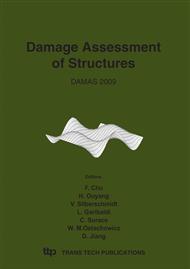p.313
p.327
p.335
p.343
p.351
p.359
p.367
p.373
p.383
Bayesian Logic Applied to Damage Assessment of a Smart Precast Concrete Element
Abstract:
This paper presents the laboratory validation of a prototype optic-fiber instrumented structural element. The element is a reduced-scale reinforced concrete beam, of dimensions 3.8×0.3×0.5m that can be pre-stressed by an internal Dywidag bar. The sensing technology is based on a multiplexed version of the SOFO strain sensor, prepared in the form of a 3-field smart composite bar; in-line multiplexing is obtained by separating each measurement field through broadband FBGs. The experiment aims to identify the response of the sensors to differing damage conditions artificially produced in the element, including cracking and loss of prestressing. A numerical algo-rithm, based on Bayesian logic, is applied to real-time diagnosis: by processing the sensor meas-urements and prior information, the method assigns a posterior probability to each assumed damage scenario, as well as the updated probability distributions for each relevant structural parameter. With respect to classical damage detection approaches, the merit of those based on Bayesian logic is to provide not only information on the damage, but also the degree of confidence in this informa-tion. The paper discusses the ability of the system to identify the differing damage conditions. The reported test clearly shows that an occurrence such as a loss of prestressing can be recognized early with a high degree of reliability based on the strain data acquired.
Info:
Periodical:
Pages:
351-358
Citation:
Online since:
June 2009
Authors:
Keywords:
Price:
Сopyright:
© 2009 Trans Tech Publications Ltd. All Rights Reserved
Share:
Citation:


